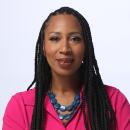Inglewood gallery’s closure dimmed artists’ dreams
- Share via
Artist Kohl King frequents many exhibit openings throughout Los Angeles, sipping on the free wine as she seeks inspiration. But it was a little-known gallery in Inglewood that caught her by surprise.
Abstract works adorned the wall of the first floor of the Beacon Arts gallery. The exhibit, “Optimist’s Parking Lot,” spilled over onto the top level of the four-floor building. There, colorful structures that incorporated Christmas lights and train tracks seized the art aficionado’s attention.
For King, it was more than the works that haunted her. It was the space itself.
“It was so intimate, wonderful, contemporary and inspiring,” said King, a mixed-media artist. “The gallery put Inglewood on the map.”
But when the city hosts its annual Inglewood Open Studios this fall, a two-night event of studio-hopping that allows local artists to showcase their works, the Beacon Arts gallery will receive its first visitors in months.
This summer, the gallery quietly shut down after mustering only a small following, mostly of artists. The closing pushed back the city’s dreams of creating a cultural district that would highlight the burgeoning art community.
“It made a lot of noise for its size,” said real estate developer Scott Lane. “But it wasn’t fulfilling its destiny as a dynamic force. It was a meek storefront.”
The space will temporarily reopen during Open Studios as a “pop-up gallery.”
Initially, it wasn’t hard getting art enthusiasts to make the trek into Inglewood. The gallery’s location off La Brea Avenue, a major city thoroughfare, was a plus.
But getting people to buy the pricey paintings — some for upward of $60,000 — became a challenge.
Still, the dozens of artists who have set up studios in the city pinned their hopes on the gallery as the first piece of what would become a vibrant art hub that would rival Venice, Santa Monica and Culver City.
For years, sculptors and painters have been quietly trickling into Inglewood, lured by cheaper rent and the cool ocean breeze.
Many settled into clusters tucked away in pockets throughout the city.
A concentration of architects, photographers and musicians live and work inconspicuously behind a chain link fence off Hyde Park Boulevard. A half-mile away, a handful of painters hole up along a street corner.
They have to maintain a low profile. Many of their studios double as their homes, an illegal practice that the artists have been trying to change by lobbying the city to allow live-work permits.
Kenneth Ober, one of the pioneers, converted a spare room in his fourplex into a work space, where he paints conceptual pieces that require thousands of tiny brush strokes. When he moved to Inglewood more than a decade ago, he felt he had few options.
“Downtown was too hot,” he said. “Venice and Culver City was too expensive. And Hollywood was cranked on steroids or Starbucks.”
In Inglewood, Ober found inspiration from his diverse surroundings. He painted a collection inspired by the fireworks that burst from his neighbors’ backyard during the Fourth of July. Unlike in L.A., pyrotechnics are legal here.
The loose network of artists eventually came together in 2006 to form the Inglewood Open Studios. The tour is the closest thing the city has to an art walk, Ober said.
Soon, students from the nearby Otis College of Art and Design joined in.
Seeing a market, real estate developers transformed a half-empty storage facility into art studios in 2010. The Beacon Arts Building was “located in the heart of the burgeoning Inglewood Arts District,” according to its website.
In reality, the four-story concrete monolith was the only art-related property in the area.
Across town, a former Volkswagen dealership on Manchester Boulevard constituted the other artsy area — a batch of 40 studios called 1019 West.
The Beacon Arts gallery opened as emerging and established artists started renting space in the warehouse-style building. There was always a nice turnout during exhibit openings as art lovers realized that the city’s reputation as crime-ridden was unwarranted.
Initially, Lane hired security guards, but he later realized they were unnecessary since parts of Inglewood turned into a quiet, sleepy city after dark. The gallery attracted a following in the eclectic art community. Well-known artists such as China Adams, Steven Bankhead and Fay Ray created a big draw.
“The artwork was meant to reach in and shake everybody up,” Scott said. “It was avant-garde and a little off the wall.”
But what Lane needed was deep-pocketed buyers to help offset the nearly $5,000 monthly cost of running the space. Still, he said he’s optimistic. He hopes the gallery can be resurrected, but this time with the help of a private investor.
And if all else fails, Lane said he may convert the space into additional artist studios.
King, who moved into one of the studios last year, said she was “heartbroken” when she learned of the gallery’s closing. She and the other 30 artists who still work at the Beacon building tried to figure out ways to save it, but didn’t have the resources.
“There’s an opportunity for growth and change,” she said.
angel.jennings@latimes.com
More to Read
Sign up for Essential California
The most important California stories and recommendations in your inbox every morning.
You may occasionally receive promotional content from the Los Angeles Times.














